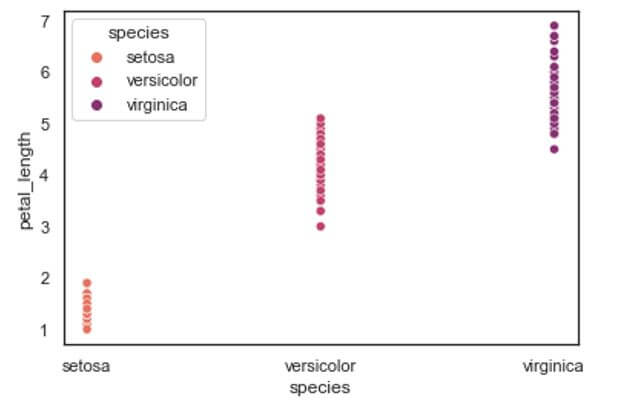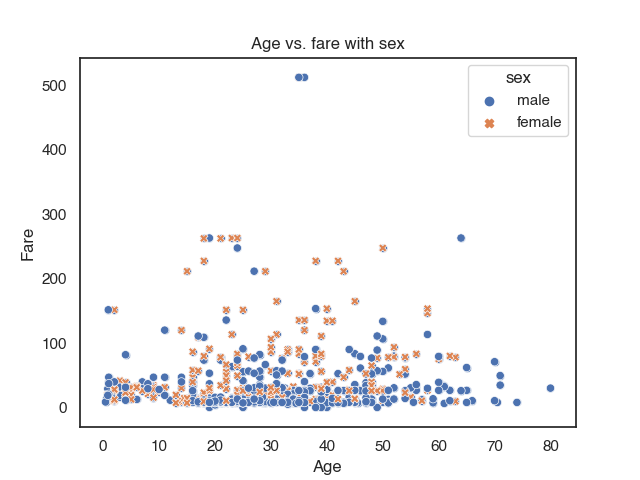

- #Seaborn scatter plot axis range how to
- #Seaborn scatter plot axis range full
- #Seaborn scatter plot axis range code
Scatterplot() (with kind="scatter" the default)Īs we will see, these functions can be quite illuminating because they use simple and easily-understood representations of data that can nevertheless represent complex dataset structures.
#Seaborn scatter plot axis range code
Consider the following code that will render the simple scatter plot we see below. This style works well if your data points are labeled, but dont really form. relplot() combines a FacetGrid with one of two axes-level functions: I am generating some plots using matplotlib and seaborn, and the x-axis and y-axis are different lengths as shown in an example below. Use Seaborn xlim and setylim to set axis limits. Seaborn makes it incredibly easy to generate a nice looking labeled scatter plot. This is a figure-level function for visualizing statistical relationships using two common approaches: scatter plots and line plots. You can also use sns.despine () to only show the x and y-axis but no 'spines' at the top and right. You can use sns.setstyle ('whitegrid') to have a white facecolor. That has no border (so also no line for x and y axis), a grey facecolor and white grid lines. We will discuss three seaborn functions in this tutorial. You seem to have explicitly set the default seaborn theme. DataFrame ( data, index, 'a', 'b', 'c', 'd' ) sns. Visualization can be a core component of this process because, when data are visualized properly, the human visual system can see trends and patterns that indicate a relationship. daterange ('1 1 2000', periods 100, freq 'm', name 'date') data np. This can be done using the plt.xlabel() and plt.ylabel() functions respectively. Similar to adding a title to a Seaborn plot, we can use Matplotlib to add x-axis and y-axis labels.
#Seaborn scatter plot axis range how to
How to Add Labels to Python Seaborn Scatter Plots. Print(g) # -> AxesSubplot(0.672059,0.11 0.227941x0.Statistical analysis is a process of understanding how variables in a dataset relate to each other and how those relationships depend on other variables. In the following section, you’ll learn how to add axis labels to a Seaborn scatter plot. # y-axis need to start at zero and end at one # y-axis needs to start at zero and end at 10 You could loop over them and set the xticks on each one, but an easier way is to call t (xticksnp.arange (1,4,1)), which will do the loop internally. (): Axes module of matplotlib library is used to set the y-axis view limits. We will discuss three seaborn functions in this tutorial. 1 Answer Sorted by: 24 setxticks is a method on a matplotlib Axes object, but FacetGrid has many axes. I don't get any errors, but the solution also does not work for me.įig, axes = plt.subplots(nrows=1, ncols=3, figsize=(24, 6))ĭf.groupby(, as_index=False).sum() There are two methods available in the Axes module to change the limits: (): Axes module of matplotlib library is used to set the x-axis view limits. I tried the solution mentioned here from the Seaborn author. However, for comparison purposes I want the y-axis in all graphs starting at zero and the ending at a specific value. 0,1,2) you can set the xticks and xticklabels manually. If you want to include the months lower than the minimum (i.e.

ax.set (xlim (-0.5, 8.5)) Which will give you. It creates a scatter plot where predicted values are marked in blue, and actual values in red, displaying them along the x-axis range. In the meanwhile, one can create a custom version of sns.scatterplot that does excatly that. The easiest way to fix this (though it does not fix the underlying data and won't work in all cases) is simply to set the limits manually to account for the offset.
#Seaborn scatter plot axis range full
If seaborn will add a type check for the x-axis, which uses plt.plotdate for date values instead, this will be fixed. When min / max variables are neither computed as part of a transform or explicitly assigned, the range will cover the full extent of the data at each unique observation on the orient axis: ( so.Plot(penguins, x'sex', y'bodymassg').


The plot has three graphs in the same figure fig, axes = plt.subplots(nrows=1, ncols=3, figsize=(24, 6)). Basically, the problem is that plt.scatter does not deal with dates well, and seaborn uses it. I'm plotting a CSV file from my simulation results.


 0 kommentar(er)
0 kommentar(er)
